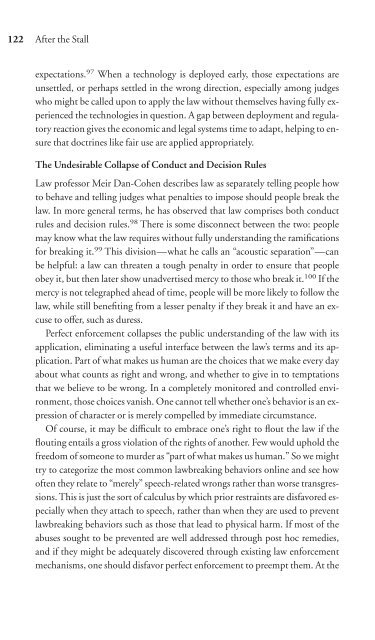Download - Future of the Internet â And how to stop it.
Download - Future of the Internet â And how to stop it.
Download - Future of the Internet â And how to stop it.
You also want an ePaper? Increase the reach of your titles
YUMPU automatically turns print PDFs into web optimized ePapers that Google loves.
122<br />
After <strong>the</strong> Stall<br />
expectations. 97 When a technology is deployed early, those expectations are<br />
unsettled, or perhaps settled in <strong>the</strong> wrong direction, especially among judges<br />
who might be called upon <strong>to</strong> apply <strong>the</strong> law w<strong>it</strong>hout <strong>the</strong>mselves having fully experienced<br />
<strong>the</strong> technologies in question. A gap between deployment and regula<strong>to</strong>ry<br />
reaction gives <strong>the</strong> economic and legal systems time <strong>to</strong> adapt, helping <strong>to</strong> ensure<br />
that doctrines like fair use are applied appropriately.<br />
The Undesirable Collapse <strong>of</strong> Conduct and Decision Rules<br />
Law pr<strong>of</strong>essor Meir Dan-Cohen describes law as separately telling people <strong>how</strong><br />
<strong>to</strong> behave and telling judges what penalties <strong>to</strong> impose should people break <strong>the</strong><br />
law. In more general terms, he has observed that law comprises both conduct<br />
rules and decision rules. 98 There is some disconnect between <strong>the</strong> two: people<br />
may know what <strong>the</strong> law requires w<strong>it</strong>hout fully understanding <strong>the</strong> ramifications<br />
for breaking <strong>it</strong>. 99 This division—what he calls an “acoustic separation”—can<br />
be helpful: a law can threaten a <strong>to</strong>ugh penalty in order <strong>to</strong> ensure that people<br />
obey <strong>it</strong>, but <strong>the</strong>n later s<strong>how</strong> unadvertised mercy <strong>to</strong> those who break <strong>it</strong>. 100 If <strong>the</strong><br />
mercy is not telegraphed ahead <strong>of</strong> time, people will be more likely <strong>to</strong> follow <strong>the</strong><br />
law, while still benef<strong>it</strong>ing from a lesser penalty if <strong>the</strong>y break <strong>it</strong> and have an excuse<br />
<strong>to</strong> <strong>of</strong>fer, such as duress.<br />
Perfect enforcement collapses <strong>the</strong> public understanding <strong>of</strong> <strong>the</strong> law w<strong>it</strong>h <strong>it</strong>s<br />
application, eliminating a useful interface between <strong>the</strong> law’s terms and <strong>it</strong>s application.<br />
Part <strong>of</strong> what makes us human are <strong>the</strong> choices that we make every day<br />
about what counts as right and wrong, and whe<strong>the</strong>r <strong>to</strong> give in <strong>to</strong> temptations<br />
that we believe <strong>to</strong> be wrong. In a completely moni<strong>to</strong>red and controlled environment,<br />
those choices vanish. One cannot tell whe<strong>the</strong>r one’s behavior is an expression<br />
<strong>of</strong> character or is merely compelled by immediate circumstance.<br />
Of course, <strong>it</strong> may be difficult <strong>to</strong> embrace one’s right <strong>to</strong> flout <strong>the</strong> law if <strong>the</strong><br />
flouting entails a gross violation <strong>of</strong> <strong>the</strong> rights <strong>of</strong> ano<strong>the</strong>r. Few would uphold <strong>the</strong><br />
freedom <strong>of</strong> someone <strong>to</strong> murder as “part <strong>of</strong> what makes us human.” So we might<br />
try <strong>to</strong> categorize <strong>the</strong> most common lawbreaking behaviors online and see <strong>how</strong><br />
<strong>of</strong>ten <strong>the</strong>y relate <strong>to</strong> “merely” speech-related wrongs ra<strong>the</strong>r than worse transgressions.<br />
This is just <strong>the</strong> sort <strong>of</strong> calculus by which prior restraints are disfavored especially<br />
when <strong>the</strong>y attach <strong>to</strong> speech, ra<strong>the</strong>r than when <strong>the</strong>y are used <strong>to</strong> prevent<br />
lawbreaking behaviors such as those that lead <strong>to</strong> physical harm. If most <strong>of</strong> <strong>the</strong><br />
abuses sought <strong>to</strong> be prevented are well addressed through post hoc remedies,<br />
and if <strong>the</strong>y might be adequately discovered through existing law enforcement<br />
mechanisms, one should disfavor perfect enforcement <strong>to</strong> preempt <strong>the</strong>m. At <strong>the</strong>


